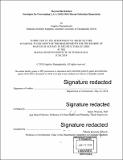| dc.contributor.advisor | James Wescoat. | en_US |
| dc.contributor.author | Siampakoulis, Angelos | en_US |
| dc.contributor.other | Massachusetts Institute of Technology. Department of Architecture. | en_US |
| dc.date.accessioned | 2018-10-15T20:25:48Z | |
| dc.date.available | 2018-10-15T20:25:48Z | |
| dc.date.copyright | 2018 | en_US |
| dc.date.issued | 2018 | en_US |
| dc.identifier.uri | http://hdl.handle.net/1721.1/118572 | |
| dc.description | Thesis: S.M., Massachusetts Institute of Technology, Department of Architecture, 2018. | en_US |
| dc.description | Cataloged from PDF version of thesis. | en_US |
| dc.description | Includes bibliographical references (pages 175-182). | en_US |
| dc.description.abstract | Beyond the Kitchen aims to propose an alternative view of thinking suburbia by suggesting the cultural and spatial consideration of its domesticity. Therefore, the thesis initiates by hypothesizing upon suburbia's contemporary popularity and proceeds through the understanding of the ranch-style typology as well as the urban and cultural forces that are at play. In this light, the research attempts to answer the following question: Can we find alternative, suburban models of living? The rationale behind this work lies in the recognition that the mid-century ranch-style house still characterizes the everyday life of the majority of suburban residents. To theorize a proposal of this nature, this thesis a) performs an instigation of the above-mentioned typology's various domestic facets and b) grounds a design proposal in Lakewood, California. The thesis begins with the proposition that the postwar ranch-style typology was a commodity, and chapter one is dedicated to an analysis of this position. By focusing on the suburban development of the city of Lakewood as a case study, my analysis reveals the methods through which the studied typology was commodified. This process, I argue, was threefold and involved: the myth of 'California Dreaming," the construction techniques used for the building of the modem ranch-style, and the use of patter catalogs for its marketing. Bound upon this recognition of commodification and hypothesizing on television's increasing popularity after the Second World War, the second part of the research asks: In a historical period steeped in technological innovation and progress, how did television influence the organization of the interior space of the suburban house? The third part of the thesis is dedicated to the analysis between aspects of commodification and spectacle, focusing on the domestic areas of ranch-style's kitchen and front lawn. Methodologically, the thesis draws evidence from literature, archival research, online surveys, site visits, interviews, and the design proposal. It employs drawing in three ways: for archival material analysis, for argument augmentation, and for design implementation. With its design, the research investigates the possibility of two strategies: the restructuring of the suburban domestic space and the reconsideration of the plot's property line. Conditioned upon this apparatus, a new domestic suburban form comes to question-among other design exercises-the possibility of a collective living project. | en_US |
| dc.description.statementofresponsibility | by Angelos Siampakoulis. | en_US |
| dc.format.extent | 410 pages | en_US |
| dc.language.iso | eng | en_US |
| dc.publisher | Massachusetts Institute of Technology | en_US |
| dc.rights | MIT theses are protected by copyright. They may be viewed, downloaded, or printed from this source but further reproduction or distribution in any format is prohibited without written permission. | en_US |
| dc.rights.uri | http://dspace.mit.edu/handle/1721.1/7582 | en_US |
| dc.subject | Architecture. | en_US |
| dc.title | Beyond the kitchen : strategies for overcoming L.A.'s 194X-196X sitcom-suburban domesticity | en_US |
| dc.title.alternative | Strategies for overcoming Los Angeles's 194X-196X sitcom-suburban domesticity | en_US |
| dc.type | Thesis | en_US |
| dc.description.degree | S.M. | en_US |
| dc.contributor.department | Massachusetts Institute of Technology. Department of Architecture | |
| dc.identifier.oclc | 1055765546 | en_US |
